BSc Agricultural Microbiology Notes Study Material
BSc Agricultural Microbiology Notes Study Material: BSc is a three-year program in most of the universities. Some of the universities also offer BSc Honours. After getting enrolled for BSc, there are certain things you require the most to get better grades/marks in BSc. Out of those, there are BSc Agricultural Microbiology Notes Study Material, BSc Sample Model Practice Mock Question Answesr Papers along with BSc Previous Year Papers. At gurujistudy.com you can easily get all these study material and notes for free. Here in this post, we are happy to provide you BSc 2nd Year Agricultural Microbiology Notes Study Material.
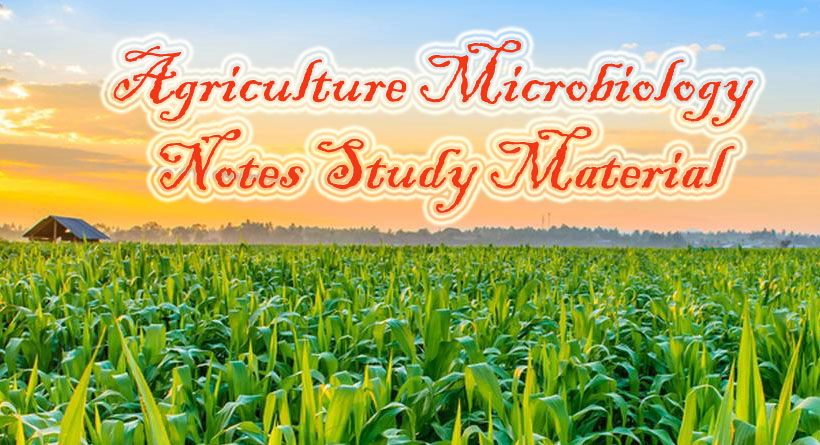
BSc Agricultural Microbiology Notes Study Material
Microbial activities are not only useful but also harmful to agriculture. Biogeochemical cycling and maintenance of soil fertility are largely attributed to activities of microorganisms. Some microbes are also able to biodegrade the pesticides used in plant protection, thus helping maintain the ecological balance.
Recently, potential of some microbes has also been realised in biological control of pests of agriculture, that could be looked as an alternative to classical chemical control. There have been efforts world over for Integrated Pest Management (IPM). Besides these helping roles, microbes are also largely responsible for biodeterioration of various materials including agricultural produce (seed, vegetable, fruit etc.) during storage, transportation and marketing.
Other materials that may be deteriorated by microbes include wood, paper, paint, leather, opticals, textiles etc. Such activities of microbes harmful to agriculture are of direct concern to environment. In this chapter we would consider in brief various microorganisms and their activities that are involved in biodeterioration (with special reference to agriculture produce), biodegradation of pesticides (pesticide microbiology) and biological control of insect pests of agriculture.
Microbial Biodeterioration
Biodeterioration is the chemical or physical alteration of a product that decreases its usefulness for its intended purpose, caused by microorganisms or their enzymes. It should not be confused with biodegradation which is a process of chemical breakdown of a substance to smaller products caused by microorganisms or their enzymes. Though both bacteria and fungi are involved in biodeterioration, the latter are relatively better known and more studied for mechanism of the process and factors which favour their growth in substrate.
Both, cellulosic and non-cellulosic materials are attacked. Cellulosic materials include wood, used as timber or as wood products, such as paper and board and other plant fibres such as cotton flax, jute, hamp and sisal used as rope, cordage, textiles and packing and filling materials. Non-cellulosic materials include plastic, glass, electric equipment, fuel, paints photographic and paint films leather, glue etc. Fungi are known deteriorate all these materials. Among fungi, mostly these are ascomycetes or Deuteromycetes. Wood is spoiled by basidiomycetes.
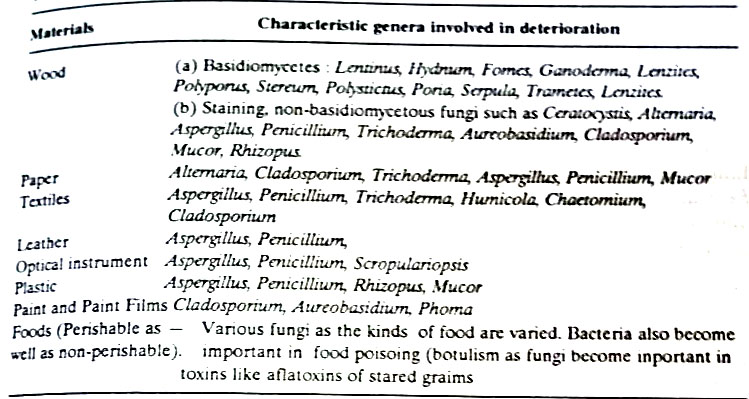
Microbial Biodeterioration of Agricultural Produce
Microbes, chiefly bacteria and fungi contaminate our grains, fruits and vegetables during storage, transport and marketing spoiling their commercial value. These microbes bring about undesirable physical and chemical changes in these products making them unsuitable for consumption. Not only this, in some cases consumption of such products contaminated by these microbes is deadly poisonous.
For instance, mycotoxins of cereals and peanuts produced by Aspergillus spp. are highly carcinogenic and deadly poisonous. Food value is altered due to changes in their carbohydrates, fats and protein contents. Such chemical changes are brought about with help of the enzymes produced by these microbes. Amylases, lipases as well as proteases are produced.
Biodeterioration of agricultural produce i.e. grains, fruits, vegetables (rhizomes, bulbs, tubers etc.) during transit and storage is of non-parasitic nature and entirely different from parasites of these produce, which bring about parasitic post- harvest diseases. Unlike weak parasites responsible for postharvest diseases of these agricultural products, the microbes responsible for biodeterioration are saprophytic and equipped with rather a relatively stronger enzymic equipment. They are biologically different from the responsible for diseases.
In India huge losses are incurred on account of different ‘types of postharvest diseases and postharvest microbial deterioration and spoilage of agricultural products. These both together are studied under the field of Market Pathology. This field concerns with the problems encountered during picking, packing, transportation and storage of produce. About 20-30% average loss is caused in India due to postharvest diseases.(BSc Agricultural Microbiology Notes Study Material)
Environmental temperature, humidity, moisture content and nutrient levels of produce are important factors in their spoilage. Besides bacteria fungal species responsible for spoilage belong to the genera Aspergillus Penicillium, Trichoderma. Fusarium, Aureobasidium, Rhizopus, Mucor, Chaetomium, Cladosporium, Stemphylium, Curvularia, Drechslera, Memnoniello Stachybotrys, Nigrospora, Pithomyces and Epicoccum.(BSc Agricultural Microbiology Notes Study Material)
Mycotoxins in Biodeterioration
Certain fungi synthesise poisonous secondary metabolites, known as mycotoxins. They induce death and also cause other toxic effects when contaminated feed/food is consumed by animals or human beings. Ingestion of mycotoxins causes intoxication, termed mycotoxicosis. Already in 1968 more than 100 toxin-producing mold species were known (Wright, 1968), mainly belonging to the fungal genera Aspergillus, Penicillium and Fusarium, and this list has since then considerably extended.
Mycotoxin production can occur in most plant products, but cereal and oilseed crops are mostly contaminated. Peanuts, cotton seed, rice and corn are mainly contaminated.(BSc Agricultural Microbiology Notes Study Material)
According to a publication by the World Health Organisation (1969), four groups of mycotoxins were considered to be causally associated with diseases in humans. These are: (i) aflatoxins, (ii) ochratoxins, (iii) zearalenone, and (iv) trichothecenes.
1. Aflatoxins. By far the most information on mycotoxin contamination is available for aflatoxin. Aflatoxin was first detected in the 1960’s as a contaminant in groundnuts, and this is a commodity likely to be contamina ted, with frequencies up to 49%. Also maize is often contaminated with frequencies up to 97%. In addition to these commodities, aflatoxin has been found in treenuts, copra and spices.
Common fungi producing aflatoxin are Aspergillus flavus, A. fumigatus, A. parasiticus and Penicillium islandicum. However, aflatoxins are produced chiefly by Aspergillus flavus and A. parasiticus, when they grow on stored food products. Over 1,000 scientific papers on aflatoxins have appeared since their discovery in 1960.(BSc Agricultural Microbiology Notes Study Material)
Aflatoxins are amongst the most potent carcinogens known, as suspected cause of liver cancer in man. It is only when they pass to liver, they are converted into toxic molecules. Aflatoxins are derivatives of furano-coumarin, and although 17 compounds have been identified, aflatoxin B1, B2, G1 and G2 are the most commonly occurring in natural products. (BSc Agricultural Microbiology Notes Study Material)
Aflatoxins, like most mycotoxins, are low-molecular weight compounds. They are heat stable so that they will survive most cooking conditions. Lactating animals ingesting aflatoxin contaminated feed excrete metabolites in the milk called aflatoxin M1.
The occurrence of aflatoxins (aflatoxin B1 + B2 + G1 + G2) in a number of plant products is shown in Tables. It is evident that aflatoxin contamination occurs in crops from tropical and subtropical areas, This reflects the fact that aflatoxin-producing strains of Aspergillus flavus are found mainly in tropical-subtropical areas, where also the optimal temperature conditions for aflatoxin production are present. Contaminated crops can be shipped to other areas, and thus practically all countries of the world are faced with the problem of aflatoxin-contaminated food stuffs.(BSc Agricultural Microbiology Notes Study Material)
2. Ochratoxins. They are produced by a number of species within the genera Aspergillus and Penicillium, with Penicillium viridicatum being the dominant producer. Ochratoxins are a group of closely related derivatives of isocoumarin linked to an aminoacid, L-beta- phenylalanine. Of the nine toxins, only ochratoxin A is occurring in natural products. It contaminates mainly grain but has also been found in coffee, beans and peanuts. This is found mainly in temperatre arease of Europe and North America.
3. Zearalenone. It is a phenolic resorcyclic acid lactone, produced by a number of Fusarium spp., e.g., Fusarium graminearum and F. moniliforme. This is found predominantly in maize, though occurs in other cereals also.
4. Trichothecenes. They possess the tetracyclic 12, 13- epoxytricho-hec-O-ene skeleton, and more than 30 trichothecenes have been identified, with T-2 toxin, nivalenol and deoxynivalenol being most commonly found. They are produced by a number of species belonging to the genera, Fusarium, Cephalosporium, Myrothecium, Trichoderma and Stachybotrys. Very few reports on these toxins have been published so far, and the understanding of these toxins as contaminants of foodstuffs is very indadequate. For details on mycotoxins the readers may go through the paper by Krough (1983).

Biodegradation of Pesticides
A range of pesticides are in current use in agriculture to control pests and diseases as well as to protect the agriculture produce from contamination by microbes responsible for their deterioration in transit and storage. The rising cost of manual labour and increasingly large-scale agricultural operations in developed and developing countries have promoted the growing use of chemicals pest control.
In USA there were only 3 insecticides in 1948 in agricultural use, but in 1975 1170 pesticides, 425 herbicides, 410 fungicides and 335 insecticides there were registered for use in that country. The pesticide used in agriculture should not have any adverse effect on non-target organisms. Unfortunately some chemicals have created environmental problems, and one of these of much concern to us is biomagnification.
Biomagnification
Besides having no adverse effect on non-target organisms, a pesticide should be biodegradable in order to minimize any possible harmful ecological side effects. Different pesticides exhibit vastly different residence times in the environment, with some persisting even indefinitely.
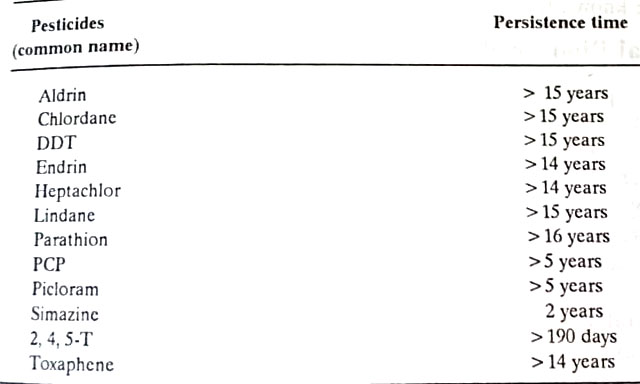
If a persistent compound enters the biosphere, it can be detected anywhere, being transferred from one organism to another through food chain. Chlorinated hydrocarbons insecticides have been detected in remote Arctic regions, 1000 miles away from the point of their introduction. Even though distribution tends to dilute the compound, they still cause concern. They do so because of the phenomenon called biomagnification, which is the increase in concentration of a chemical in biological organisms compared to its concentration in the environment.
Biomagnification occurs when the pollutant is both, persistent and lipophilic. Because of their lipophilic nature, they are partitioned from the surrounding water into the lipids of both, prokaryotes and eukaryotes, and their concentrations in microbial cell may be one to three orders of magnitude higher than those in the surrounding environment.
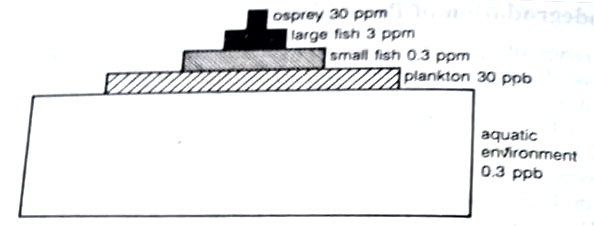
In the food web, the chemical is neither degraded nor excreted to significant levels. Thus concentrations of such chemicals increase as they are transferred to higher trophic levels. Consequently, the top consumer as birds of prey, carnivores and large fish may carry a body burden of the pollutant that exceeds the environmental concentration by a factor of 104-106 or even more. A biomagnified pesticide may cause death or serious problem to the organism. DDT and other such chemicals are known for such effects.
Microbial Biodegradation
An ideal pesticide registered for use in agriculture must be biodegradable, generally by microbes. Most of the currently used organic pesticides are biodegradable. For breakdown of chemicals in the environment there are three major natural mechanisms: (i) auto-oxidation, (ii) degradation by sunlight, and (iii) microbial degradation: Most xenobiotics (chemicals foreign to the system) go to soil and water. Since sunlight conditions are very poor in these habitats, microbial degradation is usually the only means for complete mineralisation of xenobiotics in soil and water.(BSc Agricultural Microbiology Notes Study Material)
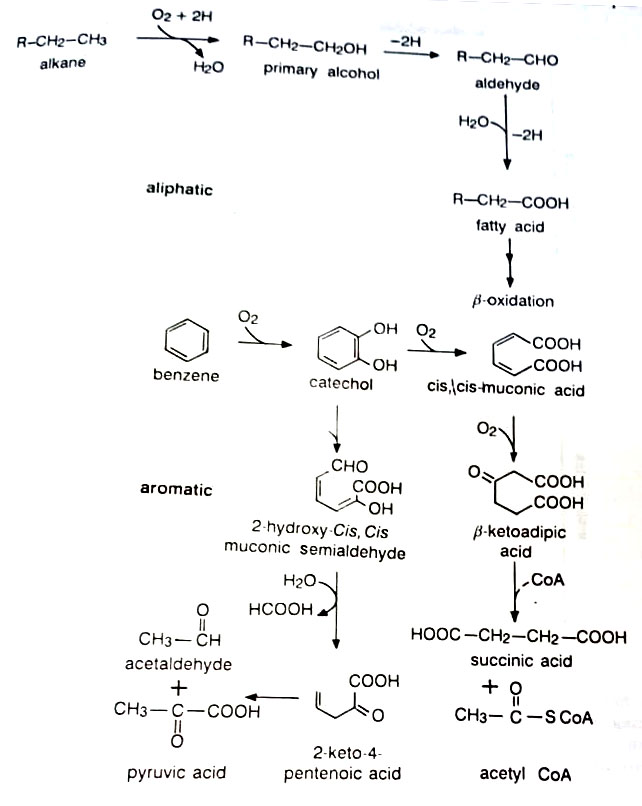
Certain metabolic processes which take place only in microbes making them unique tools for biodegradation or detoxification are, (i) fermentation, (ii) anaerobic metabolism, (iii) chemolithotrophic metabolism, (iv) metabolism through exoenzymes, and (v) adaptability to adverse environments through mutation and induction. (BSc Agricultural Microbiology Notes Study Material)
The microbes biodegrade/detoxify chemicals by enzymatic or non-enzymatic processes. The compounds are biotransformed through oxidation, reduction, hydrolysis and condensation. Synthetic pesticides mostly contain simple hydrocarbon skeletons with variety of substituents, such as halogens, amino, nitro, hydroxyl and other functional groups.
Aliphatic hydrocarbons are oxidised to fatty acids. The fatty acids are then degraded via the ß-oxidation sequence, and the resulting fragments are further metabolised via the TCA cycle. Aromatic ring structures are metabolised by dihydroxylation and ring cleavage mechanisms. Prior to these transformations, substituents on the ring may be completely or partially removed.
Substituents like halogens, nitro-and sulphonate impede oxygenation and cause recalcitrance. Often a simple change in the substituents of a pesticide may make the difference between recalcitrance i.e. complete resistance to biodegradation and biodegradability. The chemical structures of some biodegradable and recalcitrant pesticides are compared in Figure.(BSc Agricultural Microbiology Notes Study Material)
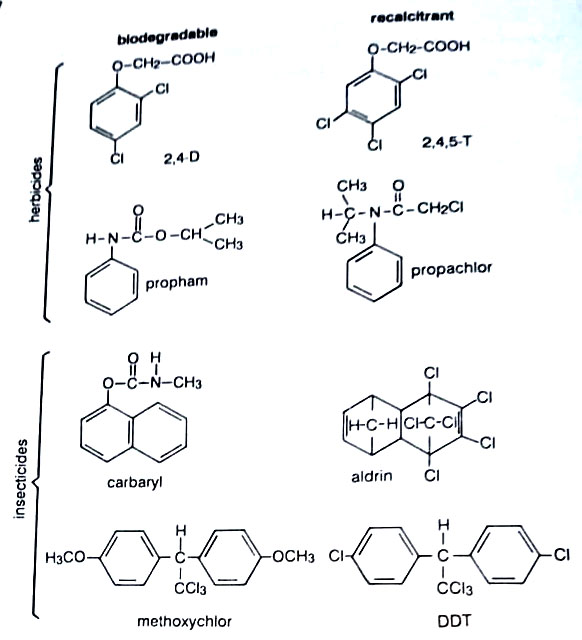
The herbicide 2,4-D is biodegraded within days, but 2, 4, 5-T, which differs only by an additional chlorine substitution in the meta-position, persists for many months. Propham is cleaved by microbial amidases rapidly, whereas propachlor with a tertiary amine group is not attacked by these enzymes and persists for longer time. Methoxychlor is less persistent than DDT because the p-methoxy groups are subject to dealkylation, and the p-chloro substitution renders DDT greater biological and chemical stability.
In some cases, one portion of the pesticide molecule is susceptible to degradation and another is recalcitrant. Some acylamide herbicides are cleaved by microbial amidases, and the aliphatic moiety of the molecule is mineralised. The aromatic moiety, stabilised by chlorine substitutions, resists mineralisation. Here microbial acyl amidases, oxidases and peroxidases are involved.
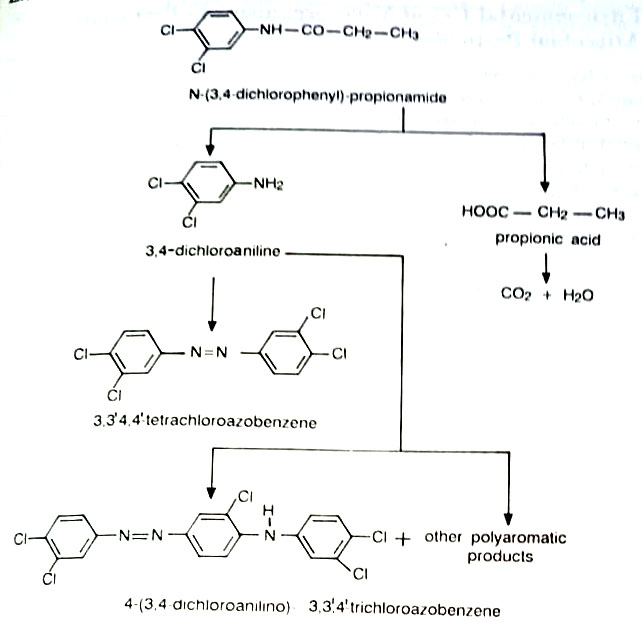
A range of microorganisms have been found to have environmental use in biodegradation of different pesticides.
Environmental Use of Microorganisms in Pest control : Microbial Pesticides
In order to minimise the use of plant protection chemicals in agriculture, biological control methods are being developed. A range of organisms been studied and microorganisms have been found ideal. They have potential of being used as microbial pesticides to protect plants from insect and nematode pests. (BSc Agricultural Microbiology Notes Study Material)
We would focus on possible use of various microbes i.e. viruses bacteria, and fungi being used in pest control. Products of these microbes are patented and registered for commercial production and he in field to protect plants from pests.
Microbial populations can be used directly for controlling plant and animal pests. Populations of pathogenic or predatory microbes that are antagonistic toward a particular pest population provide a natural means of pest control.
Preparations of such antagonistic microbial populations are called microbial pesticides. Microbial control methods have been developed for management of arthropod pests, especially insects. A microbial pesticide should be harmless to man and other valued plant and animal populations. (BSc Agricultural Microbiology Notes Study Material)
Microbial Insecticides
The greatest commercial impacts of biocontrol agents have been made in the insecticide markets. The most successful biocontrol agent has so far been the insecticidal bacterium, Bacillus thuringiensis, whose sales in forestry, agriculture and public health went much higher. Viruses, bacteria, and fungi have been used as microbial insecticides.(BSc Agricultural Microbiology Notes Study Material)
[I] Viral insecticides
Pathogenic viruses possess the potential for use as pesticidal agents. Viruses attack insects and other arthropods. The specificity of virus-host relationship makes them ideal for this purpose. They have been reported from approximately 600 insect species.
The most thoroughly studied viruses are, (i) nuclear polyhedrosis viruses (NPV), that develop in the host-cell nuclei; the virions are occluded singly or in groups in polyhedral inclusion bodies, (ii) cytoplasmic polyhedrosis viruses (CPV), that develop only in the cytoplasm of host midgut epithelial cells; the virions are occluded singly in polyhedral inclusion bodies, and (iii) granulosis viruses (GV), developing in either the nucleus or cytoplasm of host fat, tracheal or epidermal cells; the virions are occluded singly or rarely in pairs in small occlusion bodies called capsules. (BSc Agricultural Microbiology Notes Study Material)
Baculoviruses are perhaps the most carefully studied insect viruses and they include NPV and GV.
Pathogenic baculoviruses have been found principally for Lepidoptera, Hymenoptera and Diptera. Viruses have been used in attempts to control outbreaks of several insect pests including gypsy moths, Douglas fir tussock moths, pine caterpillars, red- banded leaf rollers (pest of apples), spruce budworms, codling moths (a pest of walnut & other deciduous fruits), alfalfa caterpillars, cabbage white butterflies, cabbage loopers, cotton bollworms, corn earworms, tobacco budworms, tomato worms, etc. (BSc Agricultural Microbiology Notes Study Material)
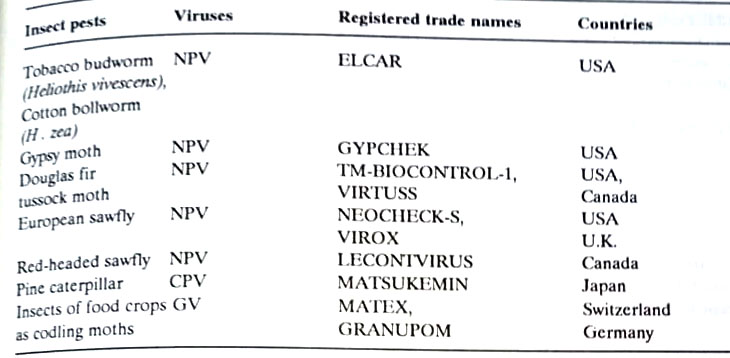
An interesting example of the use of viral pesticides is the attempt to control rabbit populations of Australia with myxoma virus.
[II] Bacterial insecticides
There are several bacterial pathogens of insects that are being used at present or have potential for use as insecticides. They include endosporeforming Bacillus and Clostridium spp. as well as non-endospore forming species of Pseudomonas, Enterobacter, Proteus, Serratia and Xenorhabdus. (BSc Agricultural Microbiology Notes Study Material)
Of these Bacillus thuringiensis has been most extensively used. Commercial preparations of B. thuringiensis are registered by more than 12 manufacturers in five countries for use in several agricultural crops, forest trees, and ornamentals for control of various insect pests. This bacterium has been tested successfully against more than 150 insect species. (BSc Agricultural Microbiology Notes Study Material)
Four separate toxins are produced by B.t. Several vegetable insect pests have been successfully managed by this bacterium. About 16 formulations based on exo- and endotoxins are used in USA, France, Germany, U.S.S.R. and Czechoslovakia. More than 30 subspecies of B.t. have been identified and called serotypes. (BSc Agricultural Microbiology Notes Study Material)
Some registered products of B.t. are, Thuricide, Sporeine, Condor, Cutlass. Foil and Invade, mostly in U.S.A. In India also, trials have been made for thuricide against insect pests of lac, cruciferous crops and white grubs of sugarcane and 0.4% thuricide has been found superior over DDT, malathion and endrin.(BSc Agricultural Microbiology Notes Study Material)
Of particular interest is the potential of B. thuringiensis israelensis (BTI) to control mosquito vectors of malaria. Unlike DOT, it is environmentally safe and there is no resistance shown in mosquito for this bacterium. Testing of BTI form malaria- carrying mosquito has been successful. The results of tests in Africa against blackfly, the carrier of widespread river blindness have been excellent, according to WHO.(BSc agricultural Microbiology Notes Study Material)
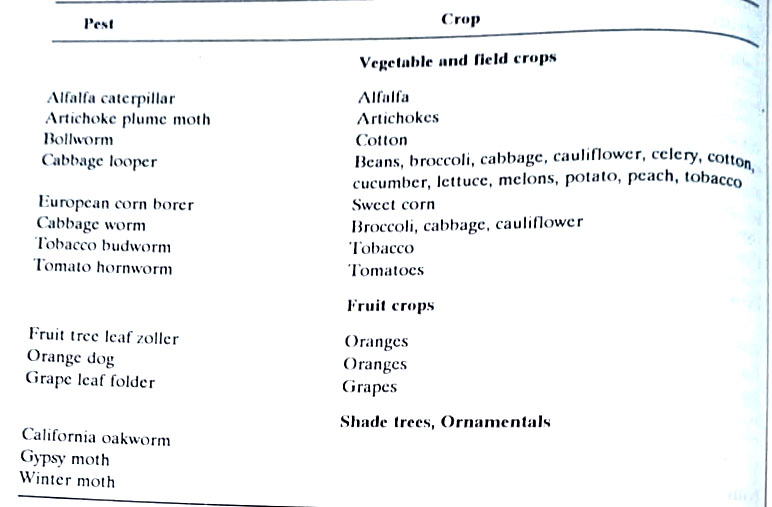
In India, trials have been made for B.t., B. popilliae and Serratia mariscens to control insect pests of sugarcane.
[III] Fungal insecticides
Fungal insecticides could become most common and effective means of control of insect pests in some countries, chiefly in ex-USSR. Products of the entomogenous fungi have been used for insects of field crops, forest trees as well as horticultural and vegetable crops grown in greenhouses. (BSc Agricultural Microbiology Notes Study Material)
Several preparations have been produced, formulated and used commercially, chiefly in ex-USSR and developing countries like Brazil, Cuba and Israel. (BSc Agricultural Microbiology Notes Study Material)
In western world fungal products have not yet been as successful as viral and B.t. insecticides. Different kinds of formulations have been developed and applied in different ways to insect pests. Though insect mycoses are caused by members of every class of fungi, most studies on entomogenous fungi have been concerned with species of the genera, Aschersonia, Beauveria, Metarrhizium, Verticillium, Hirsutella, Coelomomyces and Entomophthora. (BSc Agricultural Microbiology Notes Study Material)
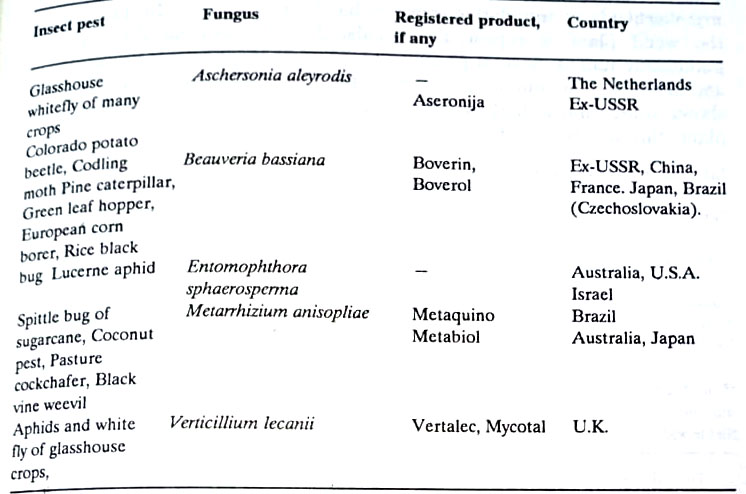
Microbial Nematicides
Most studies have been made with fungal nematicides. Classical nematode-trapping fungi belonging to the genera, Arthrobotrys, Dactylaria, Dactylella and Monacrosporium have been studied in trials to control nematode genera Meloidogyne, Heterodera and Rotylenchulus, attacking mostly vegetable crops. (BSc Agricultural Microbiology Notes Study Material)
These nematodes cause cyst and root knot diseases in these plants. There have been some limitations in the use of classical nematophagous (trap-forming) fungi for the control of these nematodes. It is difficult to manage fungi so that periods of nematode migration and trap formation coincide. (BSc Agricultural Microbiology Notes Study Material)
Another group of fungi, the soil fungi have been found more ideal nematicides. These are “opportunistic fungi” such as Verticillium chlamydosporium, Dactylella oviparasitica and Paecilomyces lilacinus that also attack eggs and young females of cyst and root-knot nematodes. (BSc Agricultural Microbiology Notes Study Material)
Of these P. lilacinus has attracted much attention as it is almost ubiquitous in tropical and substropical soils.
Microbial Herbicides
Though viruses, bacteria as well as fungi have been studied for use as herbicides, fungi could be found most suitable for the purpose. In classical strategy fungi parasitic on a particular weed plant is introduced into a new area in which the pathogen is not known to attack that weed. (BSc Agricultural Microbiology Notes Study Material)
Mostly rust fungi have been used. These include Puccinia chondrillina to control rush skeletonweed in Australia, and West U.S., and Phragmidium violaceum to control European blackberry in Chile. (BSc Agricultural Microbiology Notes Study Material)
Recently, however, a new strategy mycoherbicide or inundative strategy, has been developed. In this method, the weed plant is repeatedly inoculated with inoculum doses of the pathogenic fungus. Several products of different fungi have been developed and are in use on commercial scale in different parts of the world. (BSc Agricultural Microbiology Notes Study Material)

In all the above cases of microbial pesticides, it has been found more desirable to use biological control methods in combination with other regulatory, cultural, physical and chemical methods. (BSc Agricultural Microbiology Notes Study Material)
This led to the development of Integrated Pest Management (IPM) programmes, now undertaken in plant protection against pests and weeds. (BSc agricultural Microbiology Notes Study Material)
BSc Agricultural Microbiology Notes Study Material
BSc Agricultural Microbiology Notes Study Material
BSc 2nd Year Sample Model Practice Mock Test Question Answer Papers